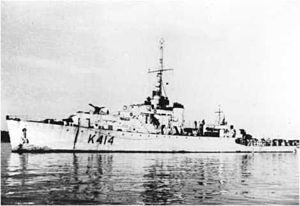 HMCS Glace Bay
| |
| History | |
|---|---|
| Name | Glace Bay |
| Namesake | Glace Bay, Nova Scotia |
| Ordered | June 1942 |
| Builder | Davie Shipbuilding, Lauzon |
| Yard number | 27 |
| Laid down | 23 September 1943 |
| Launched | 26 April 1944 |
| Commissioned | 2 September 1944 |
| Decommissioned | 17 November 1945 |
| Identification | K 414 |
| Honors and awards | Atlantic 1944–1945[1] |
| Fate | Sold to Chilean Navy |
| Name | Esmeralda |
| Acquired | 1946 |
| Out of service | 1960 |
| Renamed | Baquedano (1952) |
| Fate | Sold for breaking up 1968 |
| General characteristics | |
| Class and type | River-class frigate |
| Displacement | 1445 |
| Length | 301.5 ft (91.90 m)o/a |
| Beam | 36.6 ft (11.16 m) |
| Draught | 9 ft (2.7 m); 13 ft (4.0 m) (deep load) |
| Installed power | 5,500 hp (4,100 kW) |
| Propulsion | 2 × Admiralty Boilers |
| Speed | 20 knots (37.0 km/h) |
| Range | 7,200 nautical miles (13,334 km) at 11 knots (20.4 km/h) |
| Complement | 8 officers, 133 ratings |
| Armament |
|
HMCS Glace Bay was a River-class frigate built for the Royal Canadian Navy (RCN) in 1943. Commissioned in 1944 she served in the Battle of the Atlantic until the end of the Second World War. After the war, she was sold to the Chilean Navy and renamed Esmeralda.
Glace Bay was ordered as HMCS Lauzon in June 1942 as part of the 1943-1944 River-class building program.[2][3][4] She was laid down on 23 September 1943 by Davie Shipbuilding at Lauzon, Quebec and was launched on 26 April 1944.[4] Her name was changed to Glace Bay, and she was commissioned into the RCN on 2 September 1944 at Lévis, Quebec.[2][3]
- ^ "Volume 2, Part 1: Extant Commissioned Ships - HMCS Glace Bay". Directorate of History and Heritage. Archived from the original on 16 December 2012. Retrieved 15 March 2014.
- ^ a b Lenton, H.T.; Colledge, J.J. (1968). British and Dominion Warships of World War II. New York: Doubleday and Company Inc. p. 230.
- ^ a b Macpherson, Ken; Burgess, John (1981). The ships of Canada's naval forces 1910-1981 : a complete pictorial history of Canadian warships. Toronto: Collins. ISBN 0-00216-856-1.
- ^ a b "HMCS Glace Bay (K 414)". uboat.net. Retrieved 23 March 2014.